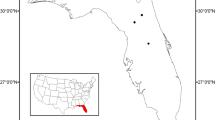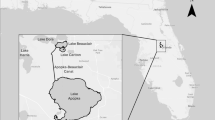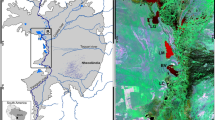Abstract
Lake Mattamuskeet, North Carolina, USA is a large (162 km2) and shallow (mean depth = 1 m) coastal lake, which was significantly modified to support agricultural activities following European settlement in 1850. Paleolimnological proxies measured on a 400-cm sediment core collected from Lake Mattamuskeet reveal shifts in organic matter input and primary producer community structure in response to climatic and human impacts on the lake during the late Holocene. Stratigraphic changes in organic matter content, nutrients, metals, lignin phenols and photosynthetic pigments were used to divide the sediment core into three intervals. Interval I includes sediment deposited between A.D. 360–1584 and indicates a clear-water, sand-bottom state with low algal abundance. In addition, the lake catchment area experienced two significant fires during this interval that were recorded as charcoal layers in the core around A.D. 360 and A.D. 1435 (calibrated 14C AMS dates). Trophic structure changed with the onset of Interval II (A.D. 1584–1860) when total algal abundance increased, and the primary producer community was comprised primarily of diatoms, chrysophytes, cryptophytes and cyanobacteria. During this interval there was also an increase in terrestrial organic material input into the lake as well as a shift in plant type from woody gymnosperms to non-woody angiosperms as determined from lignin data. Sediment deposited in Lake Mattamuskeet following European settlement (Interval III, A.D. 1860-present) suggests a dramatic increase in organic-matter deposition, metals, primary-producer abundance and the onset of cyanobacterial dominance. Sedimentary evidence indicates that shallow-water primary producers can respond rapidly to climate change and human development.







Similar content being viewed by others
References
Allen RR, Crowson BL, Riggs SR (1979) The geology of Lake Phelps. Washington County Planning Department Report
Appleby PG, Oldfield F (1983) The assessment of 210Pb data from sites with varying sediment accumulation rates. Hydrobiologia 103:29–35. doi:10.1007/BF00028424
Barefoot DW (1995) Touring the backroads of North Carolina’s upper coast. John F. Blair Publishing, Winston-Salem, NC
Benkert K (1990) Limnological assessment of Lake Mattamuskeet and Pungo Lake in relation to metal residue in biota and sediments. US Fish and Wildlife Service, Raleigh, NC, p 74
Bianchi TS, Rolff C, Lambert CD (1997) Sources and composition of particulate organic carbon in the Baltic Sea: the use of plant pigments and lignin-phenols as biomarkers. Mar Ecol Prog Ser 156:25–31. doi:10.3354/meps156025
Bianchi TS, Westman P, Rolf C, Engelhaupt E, Andren T, Elmgren R (2000) Cyanobacterial blooms in the Baltic Sea: natural or human-induced? Limnol Oceanogr 45(3):716–726
Bianchi TS, Mitra S, McKee B (2002) Sources of terrestrially-derived carbon in the Lower Mississippe River and Louisiana shelf: implications for differential sedimentation and transport at the coastal margin. Mar Chem 77:211–222. doi:10.1016/S0304-4203(01)00088-3
Bianchi TS, Filley T, Dria K, Pather P (2004) Temporal variability in sources of dissolved organic carbon in the lower Mississippi River. Geochim Cosmochim Acta 68:959–967. doi:10.1016/j.gca.2003.07.011
Bianchi TS, Wysocki LA, Stewart M, Filley TR, McKee BA (2007) Temporal variability in terrestrially-derived sources of particulate organic carbon in the lower Mississippi River. Geochim Cosmochim Acta 71:4425–4437. doi:10.1016/j.gca.2007.07.011
Bracco R, Inda H, Puerto LD, Castiñeira C, Sprechmann P, García-Rodríquez F (2005) Relationships between Holocene sea-level variations, trophic development, and climatic change in Negra Lagoon, Southern Uruguay. J Paleolimnol 33:253–263. doi:10.1007/s10933-004-4934-8
Brenner M, Whitmore TJ, Curtis JH, Hodell DA, Schelske CL (1999) Stable isotope (δ13C and δ15N) signatures of sedimented organic matter as indicators of historic lake trophic state. J Paleolimnol 22:205–221. doi:10.1023/A:1008078222806
Casterlin ME, Reynolds WW, Lindquist DG, Yarbrough CG (1984) Algal and physiochemical indicators of eutrophication in a lake harboring endemic species: Lake Waccamaw, North Carolina. J Elisha Mitchell Sci Soc 100:83–103
Davies SJ, Metcalfe SE, MacKenzie AB, Newton AJ, Endfield GH, Farmer JG (2004) Evironmental changes in the Zirahuén Basin, Michoacán, Mexico, during the last 1000 years. J Paleolimnol 31:77–98. doi:10.1023/B:JOPL.0000013284.21726.3d
Duan SW, Bianchi TS, Sampere TP (2007) Temporal variability in the composition and abundance of terrestrially-derived organic matter in the lower Mississippi and Pearl Rivers. Mar Chem 103:172–184. doi:10.1016/j.marchem.2006.07.003
Engstrom DR, Wright DI (2002) Sedimentological effects of aeration-induced lake circulation. Lake Res Manage 18:201–214
Firestone RB, West A, Warwich-Smith S (2006) The cycle of cosmic catastrophies: flood, fire, and famine in the history of civilization. Bear & Company, Rochester, Vermont
Forrest LC (2000) Lake Mattamuskeet: New Holland and Hyde County. Arcadia Publishing, Charleston, South Carolina
Frey DG (1953) Regional aspects of the late-glacial and post-glacial pollen succession of southeastern North Carolina. Ecol Monogr 23:289–313. doi:10.2307/1943595
Gaiser EE, Brooks MJ, Kenney WF, Schelske CL, Taylor BE (2004) Interpreting the hydrological history of a temporary pond from chemical and microscopic characterization of siliceous microfossils. J Paleolimnol 31:63–76. doi:10.1023/B:JOPL.0000013280.72275.81
García-Rodríquez F, Mazzeo N, Sprechmann P, Metzeltin D, Sosa F et al (2002) Paleolimnological assessment of human impacts in Lake Blanca, SE Uraguay. J Paleolimnol 28:457–468. doi:10.1023/A:1021616811341
García-Rodríquez F, Sprechmann P, Metzeltin D, Scafati L, Melendi DL et al (2004) Holocene trophic state changes in relation to sea level variation in Lake Blanca, SE Uruguay. J Paleolimnol 31:99–115. doi:10.1023/B:JOPL.0000013281.31891.8e
Goñi MA, Hedges JI (1992) Lignin dimmers: structures, distribution, and potential geochemical applications. Geochim Cosmochim Acta 56:4025–4043. doi:10.1016/0016-7037(92)90014-A
Goñi MA, Teixeira MJ, Perkey DW (2003) Sources and distribution of organic matter in a river-dominated estuary (Winyah Bay, SC, USA). Estuar Coast Shelf Sci 57:1023–1048. doi:10.1016/S0272-7714(03)00008-8
Gordon ES, Goni MA (2004) Controls on the distribution and accumulation of terrigenous organic matter in sediments from the Mississippi and Atchafalaya river margin. Mar Chem 92:331–352. doi:10.1016/j.marchem.2004.06.035
Haberzettl T, Wille M, Fey M, Janssen S, Lucke A et al (2006) Environmental change and fire history of southern Patagonia (Argentina) during the last five centuries. Quat Int 158:72–82. doi:10.1016/j.quaint.2006.05.029
Håkanson L, Jansson M (1983) Principles of lake sedimentology. Springer-Verlag, New York, USA
Hedges JI, Ertel J (1982) Characterization of lignin by gas capillary chromatography of cupric oxide oxidation products. Anal Chem 54:174–178. doi:10.1021/ac00239a007
Hedges JI, Clark WA, Quay P, Richey JE, Devol AH, Santos UdM (1986) Compositions and fluxes of particulate organic material in the Amazon River. Limnol Oceanogr 31:717–738
Hodgson DA, Verleyen E, Squier AH, Sabbe K, Keely BJ, Saunders KM et al (2006) Interglacial environments of coastal east Antarctica: comparison of MIS 1 (Holocene) and MIS 5e (Last Interglacial) lake-sediment records. Quat Sci Rev 25(1–2):179–197. doi:10.1016/j.quascirev.2005.03.004
Inda H, García-Rodríquez F, Puerto Ld, Acevedo V, Metzeltin D (2006) Relationships between trophic state, paleosalinity and climatic changes during the first Holocene marine transgression in Rocha Lagoon, southern Uruguay. J Paleolimnol 35:699–713. doi:10.1007/s10933-005-4841-7
Ingram RL (1987) Peat deposits of North Carolina. Department of Natural Resources and Community Development, Division of Land Resources, Geological Survey Section. Bulletin 88, Raleigh, NC
Jeffrey SW, Mantoura RFC, Wright SW (eds) (1997) Phytoplankton pigments in oceanography. UNESCO Publishing, Paris
Kenney WF, Waters MN, Schelske CL, Brenner M (2002) Sediment records of phosphorus-driven shifts to phytoplankton dominance in shallow Florida lakes. J Paleolimnol 27:367–377. doi:10.1023/A:1016075012581
Leavitt PR (1993) A review of factors that regulate carotenoids and chlorophyll deposition and fossil pigment abundance. J Paleolimnol 9:109–127. doi:10.1007/BF00677513
Leavitt PR, Hodgson DA (2001) Sedimentary pigments. In: Smol JP, Birks HJP, Last WM (eds) Tracking environmental change using lake sediments, terrestrial, algal, and siliceous indicators, vol 3. Kluwer Academic Publishers, Dordrecht, The Netherlands, pp 295–325
Leavitt PR, Cumming BF, Smol JP, Reasoner M, Pienitz R, Hodgson DA (2003) Climatic control of ultraviolet radiation effects on lakes. Limnol Oceanogr 48(5):2062–2069
McGowan S, Leavitt PR, Hall RI, Anderson NJ, Jeppesen E, Odgaard BV (2005) Controls of algal abundance and community composition during ecosystem state change. Ecology 86:2200–2211. doi:10.1890/04-1029
Onstad GD, Canfield DE, Quay PD, Hedges JI (2000) Sources of particulate organic matter in rivers from the continental USA: lignin phenol and stable carbon isotope compositions. Geochim Cosmochim Acta 64(20):3539–3546. doi:10.1016/S0016-7037(00)00451-8
Patione A, Graham MD, Leavitt PR (2006) Spatial variation of nitrogen fixation in lakes of the northern Great Plains. Limnol Oceanogr 51(4):1665–1677
Pienitz R, Smol JP, Last WM, Leavitt PR, Cumming BF (2000) Multi-proxy Holocene palaeoclimatic record from a saline lake in the Canadian Subartic. Holoc 10(6):673–686. doi:10.1191/09596830094935
Reimer PJ, Baillie MGL, Bard E et al (2004) IntCal04 terrestrial radiocarbon age calibration, 0–26 cal kyr BP. Radiocarbon 46(3):1029–1058
Scheffer M (1998) Ecology of shallow lakes. Kluwer Academic Publishers, London, UK
Schelske CL, Peplow A, Brenner M, Spencer CN (1994) Low-background gamma counting: applications for 210Pb dating of sediments. J Paleolimnol 10:115–128. doi:10.1007/BF00682508
Schelske CL, Lowe EF, Battoe LE, Brenner M, Coveney MF, Kenney WF (2005) Abrupt biological response to hydrologic and land-use changes in Lake Apopka, Florida, USA. Ambio 34:192–198. doi:10.1639/0044-7447(2005)034[0192:ABRTHA]2.0.CO;2
Stahle DW, Cleaveland MK (1994) Tree-ring reconstructed rainfall over the southeastern USA during the Medieval Warm Period and Little Ice Age. Clim Change 26:199–212. doi:10.1007/BF01092414
Stahle DW, Cleaveland MK, Hehr JG (1988) North Carolina climate changes reconstructed from tree rings: A. D. 372 to 1985. Science 240:1517–1519. doi:10.1126/science.240.4858.1517
Stahle DW, Cleaveland MK, Blanton DB, Therrell MD, Gay DA (1998) The Lost Colony and Jamestown droughts. Science 280:564–567. doi:10.1126/science.280.5363.564
Stahle DW, Fye FK, Cook ER, Griffin RD (2007) Tree-ring reconstructed megadroughts over North America since A. D. 1300. Clim Change 83:117–131. doi:10.1007/s10584-006-9171-x
Reynolds CS (2006) The ecology of phytoplankton. Cambridge University Press, Cambridge, UK
Vega AJ, Sui CH, Lau KM (1998) Interannual to interdecadal variations of the regionalized surface climate of the United States and relationships to generalized flow parameters. Phys Geog 19:271–291
Vega AJ, Rohli RV, Sui CH (1999) Climatic relationships to Chesapeake Bay salinity during Southern Oscillation extremes. Phys Geog 20:468–490
Waters MN (2007) Historic transitions in primary producer communities in eastern North Carolina lakes. PhD Dissertation, University of North Carolina, Chapel Hill
Whitehead DR (1981) Late-Pleistocene vegetational changes in northeastern North Carolina. Ecol Monogr 51(4):451–471. doi:10.2307/2937324
Willard DA, Cronin TM, Verardo S (2003) Late-Holocene climate and ecosystem history from Chesapeake Bay sediment cores, USA. Holo 13:201–214. doi:10.1191/0959683603hl607rp
Wyn B, Sweetman JN, Leavitt PR, Donald DB (2007) Historical metal concentrations in lacustrine food webs revealed using fossil ephippa from Daphnia. Ecol Appl 17(3):754–764. doi:10.1890/06-0868
Acknowledgments
This research was funded through two graduate research fellowships to MNW from the University of North Carolina Coastal Studies Institute and NC Beautiful and a RJR Junior Faculty Award to MFP. Dr. C. S. Martens and his research students aided in gravimetric and TOC/TN analysis. Scott Peterson provided extensive assistance and guidance with lignin-phenol analysis. Metals and nutrients were analyzed at Waters Agricultural Laboratories in Camilla, GA. We are very grateful to Dr. C. L. Schelske, Dr. D. M. Leech and two anonymous reviewers, whose comments greatly improved this manuscript.
Author information
Authors and Affiliations
Corresponding author
Rights and permissions
About this article
Cite this article
Waters, M.N., Piehler, M.F., Rodriguez, A.B. et al. Shallow lake trophic status linked to late Holocene climate and human impacts. J Paleolimnol 42, 51–64 (2009). https://doi.org/10.1007/s10933-008-9247-x
Received:
Accepted:
Published:
Issue Date:
DOI: https://doi.org/10.1007/s10933-008-9247-x




